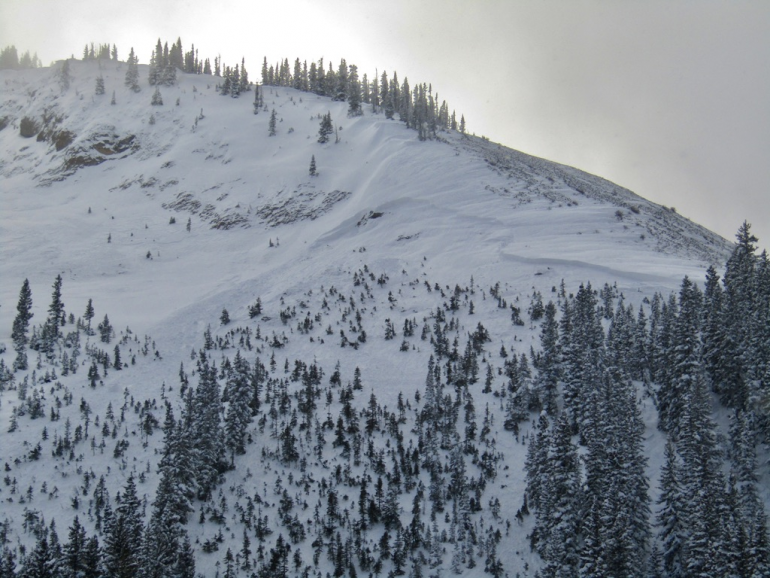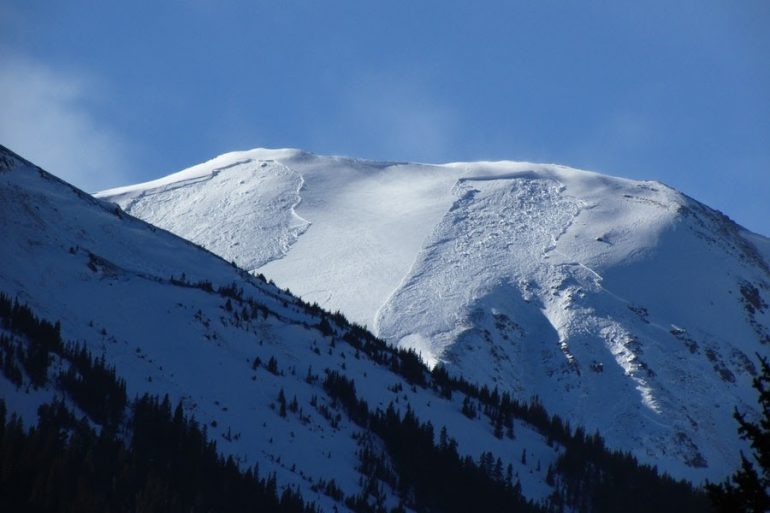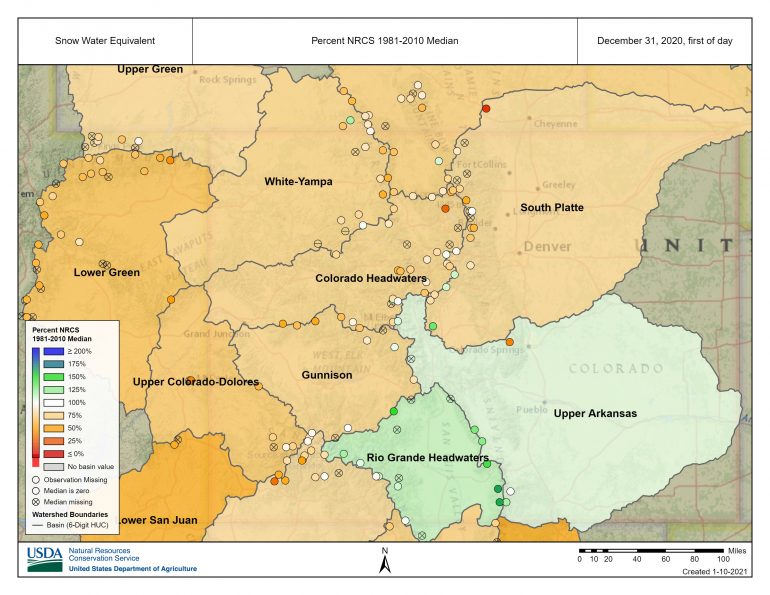December began with dry weather and a thin snowpack across Colorado’s mountains. Three storms swept across the state from the middle to the end of the month. Each storm spurred an uptick in avalanche activity. The CAIC recorded historic numbers of human-triggered avalanches in two separate week-long stretches during and after these storms.
Despite a snowy finish to the month with a foot of snow across the Northern Mountains and one to two feet in the Central and Southern Mountains, the snowpack remained shallow compared to typical years.

This image shows the snow water equivalent (SWE) at the start of December as a percent of median compared to December 1, 1981 to 2010. Each circle is an individual SNOTEL station, and SWE amounts are extrapolated over river basins. Image courtesy of the National Resources Conservation Service.
The CAIC recorded 1165 natural or human-triggered avalanches in December, of which 429 were large enough to bury, injure, or kill a person (D2 or bigger on the destructive scale). Of the 341 human-triggered avalanches, 62 were D2 or larger. There was an unusually large proportion of small avalanches (D1 on the destructive scale) triggered by people through the month, largely due to the low snowpack volume. As snow accumulated, the avalanche size increased. Twenty four people were caught in 23 different avalanches during the month. Seven people were buried, and tragically four people died. Those were the first avalanche fatalities in Colorado for the 2020-21 season.

Human-triggered avalanches by week starting from October 1. The solid line is all human-triggered avalanches, the dashed line the portion of those large enough to injure or bury a person. Thinner lines indicate the 75th, median, and 25th percentiles for weekly avalanches between 2010-11 and 2019-20.
The first ten days of December were dominated by a high-pressure blocking pattern, which extended the dry weather streak that began in late November. This dry weather resulted in a period where the upper portion or entire snowpack developed into cohesionless faceted grains. Toward the end of this period, loose snow avalanches gained considerable mass as they entrained more and more of the faceted snow. Warmer daytime temperatures in the Central and Southern Mountains formed thin crusts on lower elevation, south-facing slopes. The weak snow and thin crusts would become problematic once they were buried by subsequent storms. With the exception of two days where winds increased avalanche danger in the Sangre de Cristo zone, the avalanche danger remained LOW (Level 1 of 5) for the CAIC’s ten forecast zones from December 1 until December 10.

A loose snow avalanche running to the ground, Vail and Summit County Zone December 9 2020.
The first in a series of storms began on December 10. Over the next three days, the Northern Mountains would pick up about six inches of snow, the Central Mountains about a foot, and the Southern Mountains about nine inches. Winds were strong during and after the snowfall. This storm quickly ramped up avalanche activity and the avalanche danger. A forecaster described the “rude winds” blasting and ravaging snow near and above treeline. The CAIC issued a statewide Special Avalanche Advisory on Dec 12 to warn backcountry travelers about the abrupt change in avalanche conditions.
The CAIC recorded 93 human-triggered avalanches between December 10, and 17, the largest number of human-triggered avalanches recorded in a one week period in 10 years of CAIC data records. Luckily, due to the shallow snowpack, only three of these avalanches were large enough to bury or injure a person (D2 or larger).
There were no avalanche incidents during the stormiest period, but three people were caught in avalanches on December 14, 15, and 17, respectively. On December 15, a backcountry snowboarder was injured in an avalanche northwest of Crested Butte. That was one of the few large avalanches that occurred in this period.
The next snowy period began December 18 and finished on December 21, with about three to six inches in the Northern Mountains and roughly double that in the Central and Southern Mountains. The CAIC recorded the second largest number of human-triggered avalanches in 10 years during the week of December 17 to 23. There were 83 human-triggered avalanches, 19 of which were D2 or larger.
On December 18, a solo backcountry skier was caught, buried, and killed in an avalanche west of Crested Butte. The avalanche broke in the faceted snow that developed in November and early December. Another group backcountry skiing in the area realized the solo skier was late, and discovered him buried in the avalanche.

The crown of a fatal avalanche on December 18, 2020, west of Crested Butte. A backcountry skier traveling alone was caught, buried, and killed in this avalanche.
On December 19, two backcountry skiers were caught and killed in an avalanche southeast of Ophir. The pair were ascending low-angle terrain in the bottom of a large avalanche path known as the North Face of Battleship. Realizing the pair had not returned, a group of friends skied into the area and found the pair late that night. Again, the avalanche broke in the faceted snow that developed in November and early December. Only about 5% of avalanche fatalities in Colorado occur within two days of the previous fatality, so it was rare to have these tragic events so close together. By December 20, seven other people triggered and were caught in avalanches with less tragic consequences.

A backcountry skier triggered and was caught in this avalanche near Monarch Pass, December 19 2020. The skier triggered an avalanche airbag and was uninjured.
Two storms hit the Northern Mountains on December 23 and 27 both bringing a few inches of snow and strong winds. Though modest snow amounts, these storms were enough to overload the weak and shallow snowpack. Cycles of natural avalanches followed each storm. The CAIC did not receive reports of anyone being caught in avalanches after December 20 until tragedy struck again on December 26. That afternoon, a backcountry skier left a trailhead north of Berthoud Pass. He planned to climb a ridge and descend to First Creek, the next trailhead north, where his family would meet him. He never arrived. Search and rescue volunteers found the skier buried in avalanche debris. The avalanche was fairly small, but ran through a narrow cliffy chute. It, too, broke in the old snow near the ground.

Large natural avalanches in the Front Range forecast zone on December 26, 2020.
The First Creek fatality was the fourth and final fatal avalanche of December. Seven more people were caught in avalanches before the month ended. Most of those involvements came in the last three days of the month, when a storm impacted all of the Colorado mountains. The Northern Mountains, again, only received a few inches of snow but it was sufficient to trigger another avalanche cycle. In the Central Mountains, snow added up to a foot or more across much of the Gunnison, Aspen, and Sawatch Zones. Twelve to 20 inches of snow fell in the Southern Mountains.
Avalanche danger spiked, and on December 29 the CAIC issued Avalanche Warnings for all zones in the Central and Southern Mountains. The CAIC recorded 427 natural and human-triggered avalanches in the four days between December 28 and 31, more than a quarter of all avalanches recorded in the month. Avalanches were deep, wide, and destructive. The dangerous conditions would last into early January.

Large natural avalanches near Independence Pass, December 29 2020.
Despite the snowy finish, December was a dry month. The statewide snow water equivalent (SWE) was only 76% of the 30 year median. Most SNOTEL stations were well below typical amounts at the end of the month. The exceptions were stations Sangre de Cristo Range and eastern San Juans Mountains, where the fall pattern of greater than usual snowfall continued into December.

Statewide snow water equivalent (SWE) compared to the 30-year reference period. NRCS data.

Snow water equivalent (SWE) at the end of December as a percent of median compared to December 31, 1981 to 2010. Each circle is an individual SNOTEL station, and SWE amounts are extrapolated over river basins. Image courtesy of the National Resources Conservation Service.
